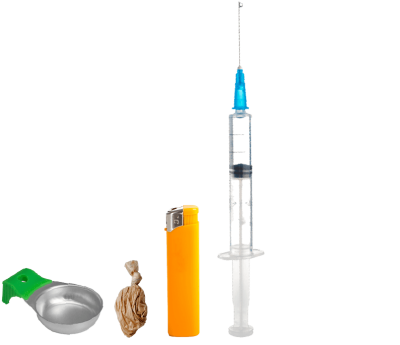
Heroin, fentanyl, and nitazenes
What is heroin?
Heroin is an opiate drug made by chemically altering morphine, which comes from opium poppies. Street names for heroin include H, brown, gear and smack. It usually comes as a fine powder ranging from an off-white to brown colour.
How is heroin used?
Snorting
The drug dissolves slowly through the lining of the nostrils and enters the bloodstream.
Smoking
You heat the powder on foil and inhale the fumes, which get absorbed into your body via the lungs, affecting you almost immediately.
Injecting
If you intend to inject heroin, you’ll need to dissolve it in citric or ascorbic acid. Injecting is a quick way to get a lot of it into your bloodstream and up to your brain, producing what you might call a ‘rush’. It’s also the most dangerous way to take it.
What are the effects of heroin?
Heroin is a downer and makes you feel calm, relaxed, safe, and warm. It can also constipate you and make you feel sick – particularly the first few times you use it.
What are the problems with heroin?
Physical dependence
You can become physically dependent after regular, repeated use. That means you’ll experience withdrawal symptoms when you stop using.
Overdose
Heroin slows down your breathing and heart rate. It can be fatal to use more heroin than you’re used to or from a more potent batch than usual.
If you haven't used heroin for a while and your tolerance levels have dropped, using the same amount as you were used to can be particularly risky.
Mixing heroin with other downer drugs, such as methadone, alcohol, and benzodiazepines, like diazepam (Valium) and temazepam, is dangerous and increases the risk of overdose.
Signs of an overdose including the following:
- confusion
- unconsciousness (unable to wake someone up when you shout or shake them)
- severe nausea and vomiting
- having a fit
- difficulty breathing
- snoring or raspy breathing
- blue/pale tingeing of knees, hands, and lips
- slow or erratic pulse (heartbeat)
- pale, cold, and clammy skin
If you think somebody is overdosing, put them in the recovery position (on their side) and call an ambulance as soon as you can. A 999 operator can also talk you through giving naloxone.
New synthetic opioids
Heroin and other drugs like illicit oxycodone, Xanax, and synthetic cannabis (spice) are increasingly mixed with new synthetic opioids like fentanyl and nitazenes.
Synthetic opioids are made in labs and mimic the effects of natural opioids such as heroin. They're much stronger than heroin – even hundreds of times stronger – and at least as potent as fentanyl. A growing number of overdoses and deaths across the country have been caused by heroin and other drugs that have been mixed with nitazenes.
You won't know if your drug has been contaminated with nitazenes because it'll look no different. But the risk of overdosing has significantly increased.
Infection
Sharing equipment, including needles, filters, containers, spoons, and water, can spread infections and blood-borne viruses like hepatitis C and HIV.
Skin damage
Repeated injections, particularly in the same spot, can cause damage to your skin and veins, leading to ulcers, abscesses, and collapsed veins.
Reduce the risks
Carry naloxone
Always carry naloxone because you can use it to reverse an opioid overdose temporarily.
You can still use naloxone even if you're unsure whether opioids are involve because it won't cause harm.
Naloxone is only a temporary fix. The person overdosing still needs immediate medical help.
If synthetic opioids are involved in the overdose, you may need to give them more than one dose of naloxone. You only need to restore breathing; they don't need to regain consciousness.
Naloxone is available from all drug and alcohol services. Make sure you find out where you can get it locally.
Don't use alone
Avoid taking drugs alone. If you do, tell someone what you're taking, how much, and when, so they can check on you.
Take it easy
Start low, go slow! Start with a small test dose to feel the effects.
Test your drugs
Fentanyl test strips can confirm the presence of fentanyl. These are available online or you can contact your local drug and alcohol service. Nitazene test strips are available from CGL Wirral Ways.
Don't mix drugs
Avoid mixing drugs, including alcohol and medicines.
Safer injecting
Use new equipment each time, including filters and sterile water. Never reuse or share anything. Filter your solution properly to remove harmful particles.
Clean the site with an alcohol swab and rotate where you inject to protect your veins. Avoid infected areas. Injecting produces the quickest effect, but it's also the riskiest way to use. Get help if you notice any signs of infection like redness, swelling, or heat.
Sterile supplies are available from needle exchanges or you can buy them online. Use colour-coded equipment so you know which kit is yours and get tested regularly for blood-borne viruses.
Stay hydrated
Smoking heroin dries out your mouth. Use lip balm, drink small sips of water regularly, and brush your teeth twice daily.
Avoid getting drawn in by dealers
A dealer might offer you more drugs than you asked for. This can be a deliberate ploy to get you indebted to them, which gives them a hold over you. Only buy what you can afford.
The law
Heroin is an illegal Class A drug.
Penalties for possession are up to 7 years in prison and an unlimited fine. Penalties for supply are up to life in prison and an unlimited fine.
For more detailed information about the law, visit the Release website.
Drugs and alcohol
Download a printable version of this page
Contacts
WMO centre
(The phone will be answered by someone speaking English)
0151 792 5116
Substance Misuse Link Worker
Nurie Lamb
Overdose
Learn how to use naloxone.










